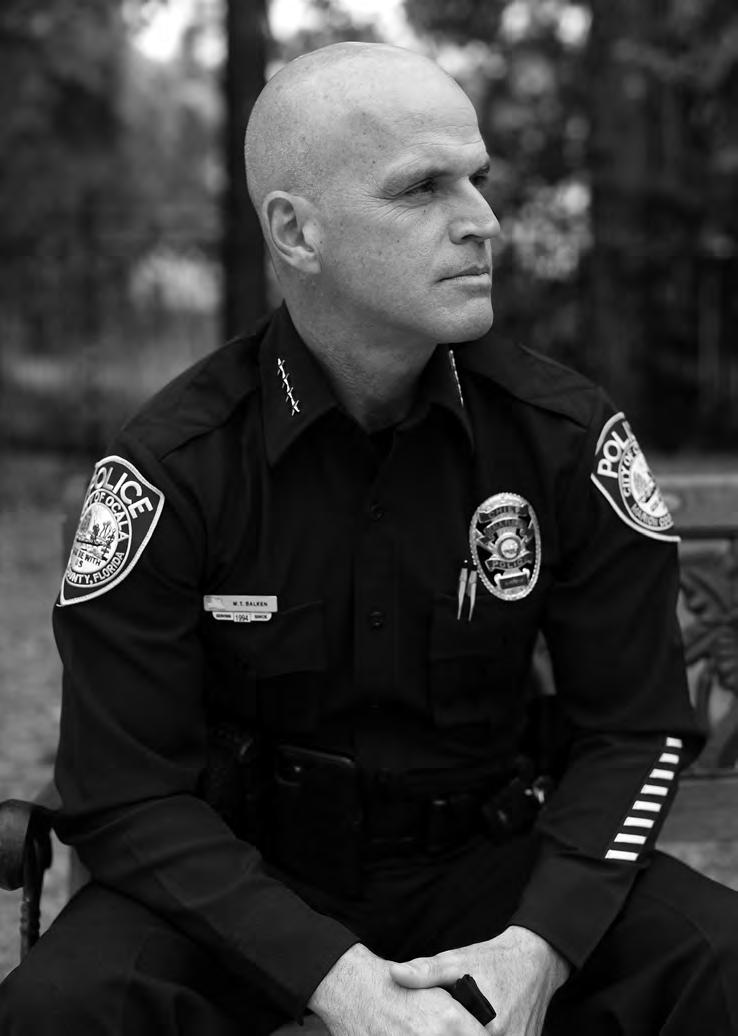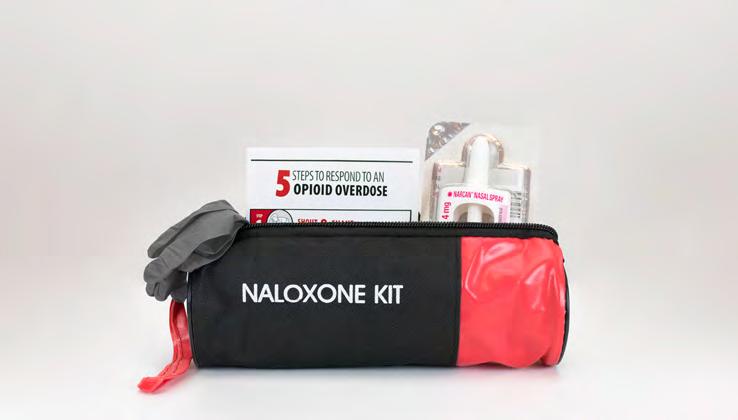
11 minute read
Ocala’s opioid crisis
from Ocala Magazine April 2021
by ocalamag
CRISIS OPIOID THE
CRISIS OPIOID BY BRAD ROGERS Opioid abuse is growing in Ocala, but the community is fighting back … and seeing some remarkable results
Advertisement

The frustration in Ocala Police Chief Mike Balken’s voice was unmistakable as he talked about the battle “WE HAVE BEEN to curb heroin/opioid use and the deaths it has brought to his community as well as the myriad efforts to wage that battle. FIGHTING THIS DRUG “It’s maddening to realize all the effort, the resources and money poured into this, WAR MOST OF OUR only to see the numbers rise,” he said. That sums up the heroin/opioid crisis in Ocala and Marion County. ADULT LIVES.”
Everyone is well aware that heroin and —OPD CHIEF MIKE BALKEN opioids are a scourge on the community, that people are overdosing and dying. Many of us likely know a family that has lost someone to opioids. Fewer are aware, however, that much has been done over the past four years to tackle the problem, and with some marked success – enough to bring Florida Attorney General Ashley Moody to town last year to praise the community as being a model for others.
Yet, the amount of opioids and heroin, as well as the number of overdoses, continues to grow steadily.
The recognition that opioids were a problem in our community first came in 2017 when the city reported 79 overdoses and 16 deaths related to opioids. The numbers alarmed Mayor Kent Guinn, who called for the formation of a task force to examine the issue and find for solutions.
“I said we’ve got to do something,” the mayor said recently. “… Everyone recognized it was a problem. Everyone kind of dove in. That’s what was so encouraging.”
The city of Ocala and Marion County keep separate running tallies on drug deaths, but their trend lines are similar – and worrisome.
In 2017, the number of overdoses in the city was 79, with 16 deaths. In 2020, there were 360 overdoses and 44 deaths. So far this year, the city has seen 56 overdoses and five deaths.
In the county, the Marion County Sheriff’s Office reports all drug-related deaths and does not break out opioid fatalities. But the pattern is the same. In 2017, there were 89 drug deaths in the unincorporated areas of the county; last year, there were 123.
Out of the mayor’s call for a task force came the Marion County Heroin/Opioid Task Force. It operates under the Marion County Children’s Alliance and is led by Nancy Castillo, who is also the coordinator Ocala Police Chief Mike Balken

Photo by Ralph Demilio
for the Community Council Against Substance Abuse. It seemed an odd assignment for the Children’s Alliance to some, but to Castillo, it was a perfect marriage.
“In Marion County, the primary reason children are removed from their homes is substance abuse,” she said. “The No. 2 reason is family violence.
“If our mission is to improve the lives of children, why wouldn’t we get involved? When the opportunity came along to lead the task force, we jumped on it.”
With a fervor. The first mission was to bring all the groups, programs and agencies that deal with drug addiction together. So, law enforcement, mental health, drug treatment, social services, health care and government got together in a room and began to talk about what Ocala could do to stop the societal mayhem opioids and heroin were causing. Castillo said the first meeting drew almost 100 people.
Steve Blank, operations manager for Perspectives Integrated Treatment in Ocala and current chairman of the Heroin/Opioid Task Force, said the trick was to bring former competitors and key community members together to talk and collaborate. The result four years later, he said, is noteworthy.
“There are a lot of good things happening,” Blank said. “But with all the good things happening, how do you determine what is going to be the biggest difference? There are only so many detox beds in Marion County. There are only so many rehab beds.”
SAVING LIVES, GIVING HOPE
The list of initiatives that have been implemented since the 2017 launch of the Heroin/Opioid Task force is impressive.
Maybe most important is the communitywide Narcan program. Narcan is the commercial name of naloxone, a drug that can reverse the effects of an overdose. Since 2017, hundreds, maybe thousands of doses of Narcan have been disbursed throughout the community. Every first responder has Narcan; many businesses have Narcan; individual families that are battling opioid addiction within have Narcan. And it has been important because, simply, it saves life after life. Here in Ocala, literally hundreds of lives.
“Narcan has saved so many people who would otherwise be dead,” Guinn said.
Narcan has been the centerpiece of an Ocala Fire Rescue program called the Community Paramedicine Program. Under the program, city Fire Rescue personnel, who have treated someone who overdosed on drugs, conduct a follow-up visit to monitor the addict’s progress. Part of the program is Narcan Leave Behind, where OFR leaves Narcan with the families of those it has treated.
Capt. Jesse Blair heads the program and said it has been “a great success.”
OFR also oversees the Ocala Recovery Project. This program, funded through a grant, gets people in a detox program and counseling.
“Somebody has to step in and communicate with that person with understanding and compassion,” Blair said. “And that’s what we try to do.”
OFR sees 50-70 overdose cases a month, he said, adding, “Every month it goes up.”
Another program that has captured the public’s attention is the Ocala Police Department’s Amnesty Program. Its aim is simple: If you are a drug addict, you can walk into any OPD office, or approach any OPD officer, and ask for help, no questions asked. The officer will then drive them to a rehab facility. Sometimes, Balken said, that means driving to Gainesville, even Daytona Beach, to find an open bed – and they do it.
Since its inception in 2018, the Amnesty Program has served more than 400 people. OPD officials aren’t sure what their success rate is, but at a tree-planting ceremony last month at The Centers to honor former OPD Chief Greg Graham for his efforts in fighting opioids and the Amnesty Program in particular, a number of people spoke about how the program had not only changed their lives but saved their lives.
One of those was Melissa Crane. Crane said she became addicted to opioids and had overdosed numerous times. The last time, she said, paramedics found her sprawled out on her bed overdosed and unconscious, ironically with a catalogue of rehab facilities laying open on the bed next to her. Two days later she entered the Amnesty Program.
“The police department didn’t let me go home,” she said. “If not for Amnesty, I wouldn’t be here.”
Today, Crane works for The Centers. “I want my recovery to speak for me.”

In 2020, there were 360 overdoses and 44 deaths.
Blank and Castillo reiterated that the lack of rehab beds is a huge hinderance to helping people. Nonetheless, in 2019, the community received funding for 15 new drug rehab beds. Yet, Castillo said the real problem is there are not enough places for people with no insurance or means of paying for treatment.
“We don’t have enough residential treatment beds for the uninsured,” she said. “Our indigent population really struggles.”
In terms of treatment, there are also a number of new facilities and programs that have opened over the past year. Lifestream at Beacon Pointe opened in early 2020 and offers a one-stop shop for drug treatment services, including counseling, cognitive behavioral therapy and medication-assisted treatment. It also offers group therapy, family therapy and peer counseling.
And coming soon is Park Place, a 10-bed facility that focuses on “medication withdrawal.”
Indeed, much is happening. But those on the front lines say while they’re winning on some fronts, they’re still losing ground, and the statistics bear them out.
FROM BAD TO WORSE
A little history. Over the years, the “opioid crisis” has evolved multiple times.
Back in the early 2000s when opioid-based painkiller OxyContin emerged and doctors were writing a flood of prescriptions for it, lawmakers took note. By that time, though, the addictiveness of OxyContin had created a new class of addicts.
Florida became ground zero in the opioid business as clinics in South Florida, known as “pill mills,” operated solely to write prescriptions for people, some of whom would drive across the country because of the easy access to quantities of Oxy.
When states, and Florida in particular, put the kibosh on the pill mills and restricted the distribution of opioid medications further, it was too late. Those addicted to Oxy and other opioid medications, their supply pipeline shot off, turned to heroin because it was cheap and available.
Instead of fixing the problem, public policy created a new one.
“That our efforts really pushed a lot of these addicts to illicit sources is really frustrating,” said OPD’s Balken.
It was no longer just prescription opi-

—NANCY CASTILLO
Nancy Castillo
oids that were creating death and heartache on a wide scale, but heroin, too.
Things, however, were going to get even worse.
Enter fentanyl. Fentanyl is a synthetic opioid that is 50-100 times more potent than morphine. It’s cheap and easy to manufacture illegally. It is flooding Ocala’s streets, Balken said. So much so that during a recent drug bust enough fentanyl was seized to kill every resident of a city twice the size of Ocala, population 60,000.
“The opioids are still the brunt of our addiction problem,” Balken said, “but the deaths are being caused by opioids laced with fentanyl.”
Police are finding fentanyl in more than just heroin and other opioids as well. It’s be-
Photo courtesy of Nancy Castillo

THE AVERAGE OVERDOSE VICTIM IN OCALA IS A 44-YEAR-OLD WHITE MALE. “WE ARE NOT GOING TO ARREST OUR WAY OUT OF THIS.”
—FORMER OPD CHIEF GREG GRAHAM
ing found in cocaine and marijuana, too. The latter worries Balken a lot.
“Fentanyl-laced marijuana is readily available on our streets,” he said. “My concern is these kids are buying stuff on the street without knowing what’s in it. What better way to get someone hooked on opioids than to lace their marijuana with an opioid?”
The average overdose victim in Ocala is a 44-year-old white male. White males, especially those in their 30s and 40s, make up the majority of Ocala’s opioid overdose victims.
Where the task force and its 25 partners – and growing – go from here is uncertain. Most of those dealing with the problem up close believe it will not be solved solely by law enforcement.
As former OPD Chief Graham was fond of saying, “We are not going to arrest our way out of this.”
For her part, Castillo said people have to start looking at addiction as the disease it is.
“It is truly a disease,” she said. “When someone has cancer, we don’t get mad at them, but we get angry that people are addicted to drugs.”
Blair echoed Castillo’s perspective and believes more people in the community – churches, civic organizations and employers – need to get involved and learn to understand what causes addiction and what it takes to overcome it.
“People have these drug addicts all wrong,” he said. “These people are warriors. They literally get up every day and fight to save their own lives. It starts with a bad decision, and then they get hooked. But there’s always some kind of trauma.”
As for Balken, “We have been fighting this drug war most of our adult lives and we have learned that law enforcement can only disrupt a small percentage of the problem. Until we can get the demand to decline, we will continue to have a problem.”
That’s where Ocala is fortunate to have the Heroin/Opioid Task Force. Not only has it made meaningful and measurable steps toward helping ease the opioid crisis in our community, it has done so in a relatively short time. That has brought praise from around the state and nation.
“We’ve come a long way, but we still have a lot to do” said Castillo, who through it all lost a close cousin to opioids. “For us being a smaller town, people are amazed how much we have accomplished. We have a lot of moving parts. We have a lot of programs. And, of course, we have a lot more to do.”










